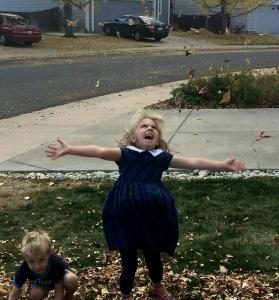More demands on my time than ever before came at the exact same time and in ways I couldn’t believe. I felt overwhelmed and needed to calm my blood pressure so I went to the Book of Mormon to find refuge for a few moments, expecting to then face the challenges with better clarity. I didn’t care where I read and happened to turn to 1 Nephi 1. I started reading, slowly and purposefully, so I could calm my runaway mind and pounding heart.
Nephi loved and honored his parents.
Lehi experienced theophany.
I read and reread verse 8 focusing on different words.
And being thus overcome with the Spirit, he was carried away in a , even that he saw the open, and he thought he God sitting upon his throne, surrounded with numberless concourses of angels in the attitude of singing and praising their God.
In the Attitude of
I fixated on attitude because I wanted to kick my freaked-out attitude to the curb. For some reason I decided to look up the meaning of attitude in the 1828 Webster’s Dictionary.
AT’TITUDE, noun [Latin actus, ago.]
1. In painting and sculpture, the posture or action in which a figure or statue is placed; the gesture of a figure or statue; such a disposition of the parts as serves to express the action and sentiments of the person represented.
2. Posture; position of things or persons.
Those definitions expressed concepts much different than what I expected — which was more like the modern definition of attitude.
a feeling or way of thinking that affects a person’s behavior.
Fascinated that attitude implied a full-body state of being, I searched the scriptures for other uses of attitude. There are only five! And they are all in the Book of Mormon!
Besides 1 Nephi 1:8 is Alma 36:22,
Yea, methought I saw, even as our father saw, God sitting upon his throne, surrounded with numberless concourses of angels, in the attitude of singing and their God; yea, and my soul did long to be there.
And Helaman 5:36
And it came to pass that he turned him about, and behold, he saw through the cloud of darkness the faces of Nephi and Lehi; and behold, they did exceedingly, even as the faces of angels. And he beheld that they did lift their eyes to heaven; and they were in the attitude as if talking or lifting their voices to some being whom they beheld.
And 1 Nephi 8:27
And [the great and spacious building] was filled with people, both old and young, both male and female; and their manner of dress was exceedingly fine; and they were in the of and pointing their fingers towards those who had come at and were partaking of the fruit.
And Alma 24:21
Now when the people saw that they were coming against them they went out to meet them, and themselves before them to the earth, and began to call on the name of the Lord; and thus they were in this attitude when the Lamanites began to fall upon them, and began to slay them with the sword.
How Do Those Attitudes Look?

I imagined the people in each verse situated in the attitude described by the verse. How would that look? How would “singing and praising their God” with body and soul look? Were Nephi and Lehi animated as they spoke to heaven? What body language did the great and spacious people portray?
How would an army calling on the Lord prostrate on the ground appear? Initially, the enemy army killed 1,005 of them as they prayed. However, their attitude impacted their enemies!
Now when the Lamanites saw [that they would lie down and , and God even in the very act of perishing,] they did from slaying them; and there were many whose hearts had in them for those of their brethren who had fallen under the sword, for they repented of the things which they had done.
And it came to pass that they threw down their weapons of war, and they would not take them again, for they were stung for the murders which they had committed; and they came down even as their brethren, relying upon the mercies of those whose arms were lifted to slay them.
Astonishing! I’ve never seen these verses in this way!
Immediately, I wondered What attitude am I in? What does my countenance convey? Does my body language convey praising God and faith-filled submission to His will? Or does it reveal an attitude of mocking others?
There are so many attitudes for expression so I’m fascinated that only these two key eternal juxtapositions are specifically related as such in the scripture.
Attitude of Prayer
Another interesting use of this concept of attitude is found in the Bible Dictionary’s section on Prayer.
The attitude of prayer ordinarily was standing (1 Sam. 1:26; Neh. 9:2, 4; Matt. 6:5; Luke 18:11, 13); also kneeling (1 Kgs. 8:54; Ezra 9:5; Dan. 6:10); or prostrate (Josh. 7:6; Neh. 8:6). The hands were spread forth to heaven (1 Kgs. 8:22; Ezra 9:5; Ps. 141:2; Isa. 1:15). Smiting on the breast and rending of the garments signified special sorrow (Ezra 9:5; Luke 18:13). The Lord’s attitude in prayer is recorded only once. In the Garden of Gethsemane He knelt (Luke 22:41), fell on His face (Matt. 26:39), and fell on the ground (Mark 14:35).
Do I pray in this “attitude of prayer?”
I’m excited to have this full-bodied concept in mind as I study the scriptures and seek to choose my attitude so I can answer yes to questions such as these:
Have you received His image in your countenance?
Does the Light of Christ shine in your eyes?
Will He know you when He comes again because you shall be like Him?
When He sees you will the Father know His child? (“His Image in Your Countenance” by Janice Kapp Perry and Felicia Sorensen)













